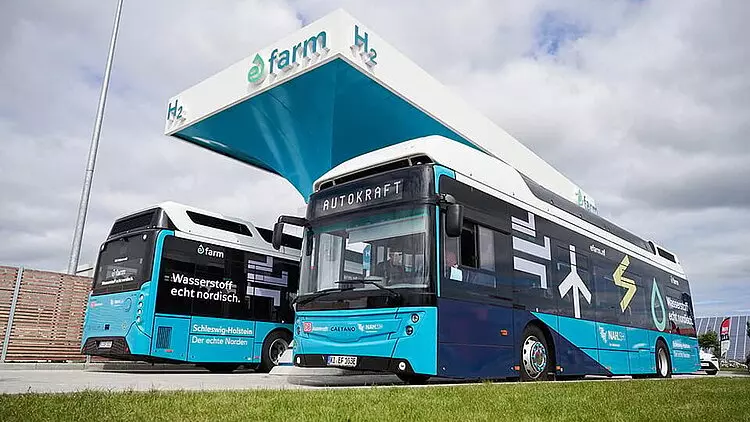Is it worth buying a fuel cell vehicle if there is no hydrogen filling station nearby? Is it worth producing hydrogen (H2) if there are no customers? To solve this chicken-and-egg problem, the “Regionale Kooperation Westküste” of the districts of North Frisia, Dithmarschen, Steinburg and Pinneberg commissioned a study on the possible use of fuel cell vehicles and sensible locations for electrolysers and hydrogen filling stations. The results were presented by two of the authors, Dr Stefan Rehm from Hypion GmbH, Heide, and Dipl.-Phys. Jürgen Meereis from IPP ESN Power Engineering GmbH, Kiel, during an online presentation. "We approached 16 stakeholders in waste management and public transport as well as 40 logistics companies, associations and other institutions in the four districts. Most of them were open to the acquisition of buses, trucks or waste collection vehicles with fuel cell propulsion," Jürgen Meereis reported. "This results in a long-term potential of 1,000 fuel cell commercial vehicles or 5,600 tons of annual hydrogen demand," added Dr Stefan Rehm.
The experts have identified the following regions as hubs or clusters for the hydrogen economy on the West Coast:
- Husum/ Niebüll with a planned fuel cell public transport project and several planned H2 filling stations
- Heide with the real-world laboratory Westküste 100, its gas infrastructure, caverns suitable for storage and already planned car station with H2 connection
- Itzehoe/ Brunsbüttel with an existing H2 filling station for cars in Büttel and a possible further H2 filling station in Itzehoe, logistics companies, chemical industry and the connection of offshore wind power plants
- Elmshorn/ Tornesch with logistics companies and waste management
"The pioneers of the renewable energy industry live on the west coast of Schleswig-Holstein. They built the first wind turbines, and now they are building the first completely renewable hydrogen filling stations," said North Frisia's District Administrator Florian Lorenzen, who opened the online presentation as deputy chairman of the “Regionale Kooperation Westküste”. "As the Energieküste, we want to market this energy potential together and want to bring the hydrogen projects out of the pilot phase and into economic viability. That's why we support our municipal companies such as the waste management companies or public transport companies in the acquisition of fuel cell vehicles."
For the implementation of a “Hydrogen Network West Coast”, the study authors recommend bringing together the companies already addressed with local representatives from business, politics and administration in the four identified hydrogen clusters to discuss and develop their suggestions for the establishment of the hydrogen hubs. With the support of the regional economic development agencies and the potential operators, a concrete filling station location could then be determined and examined for its suitability.
In the next step, the respective operator and procurement models for infrastructure and vehicles could be examined with a feasibility analysis. Afterwards, concrete planning of costs and possible subsidies could begin. According to the study, the projected hydrogen demand of 5,600 tons for 1,000 fuel cell vehicles could be reached in ten years. The production of this amount of hydrogen from electrolysis would require 300 gigawatt hours of electricity, a share of about 4% of the approximately 16,000 gigawatt hours of energy currently generated annually on the west coast from renewable sources. "Our companies are already working on implementing the energy transition. With the ‘West Coast Hydrogen Network’, we want to network them in an even more targeted way and ensure that this technology leads to value creation in our region," explained Axel Wiese from the Wirtschaftsförderungsgesellschaft Nordfriesland mbH. As project manager of the Renewable Energy Network Agency Schleswig-Holstein (EE.SH), he had helped to initiate the study and moderated the online presentation. The study "Development Paths of a Hydrogen Economy on the west coast" was financed with funds from the “Regionale Kooperation Westküste” Budget 2017-2020 and by the districts of North Frisia, Dithmarschen, Steinburg and Pinneberg. The regional budget is funded by the state programme Economy. The study is available on the website of the “Regionale Kooperation Westküste”: https://www.rk-westküste.de/startseite/
About the Energieküste
The Schleswig-Holstein North Sea coast is Germany's future location for renewable energies. Experts, researchers, creative minds and energy enthusiasts are shaping a highly innovative energy system from existing resources here. To bundle their know-how, the districts of North Frisia, Dithmarschen, Steinburg and Pinneberg founded the umbrella brand and platform "Energieküste". The aim of the districts, which have joined together to form the “Regionale Kooperation Westküste” and are regarded as incubators for innovations in the field of renewable energies, is to strengthen the existing economy, attract new companies and skilled workers and create a concise image for the business location. The "Energieküste" is financed with funds from the “Regionale Kooperation Westküste” budget, supported by the state programme Economy, and the four districts of the “Regionale Kooperation Westküste”.
Images: Publication free in connection with reporting on this press release.


